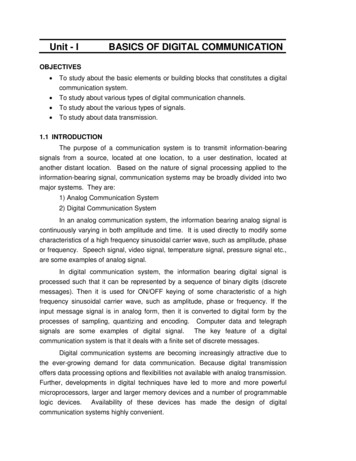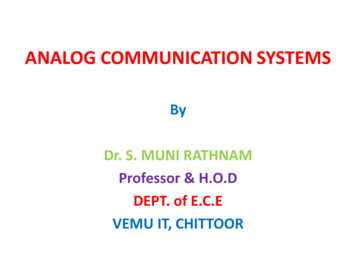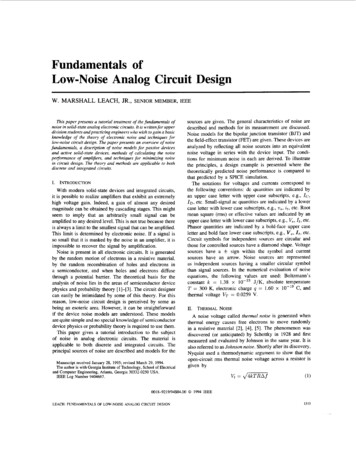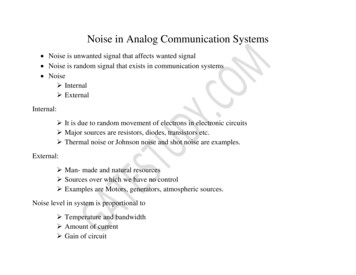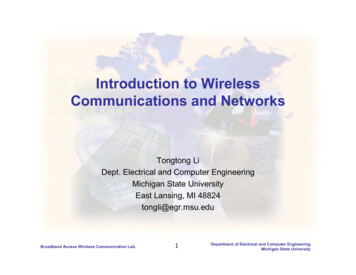
Transcription
[Document subtitle]
Analog CommunicationAbout the TutorialThe communication based on analog signals and analog values is known as AnalogCommunication.This tutorial provides knowledge on the various modulation techniques that are useful inAnalog Communication systems. By the completion of this tutorial, the reader will be ableto understand the conceptual details involved in analog communication.AudienceThis tutorial is prepared for beginners who are interested in the basics of analogcommunication and who aspire to acquire knowledge regarding analog communicationsystems.PrerequisitesA basic idea regarding the initial concepts of communication is enough to go through thistutorial. It will definitely help if you use our tutorial Signals and Systems as a reference.A basic knowledge of the terms involved in Electronics and Communications would be anadded advantage.Copyright & Disclaimer Copyright 2016 by Tutorials Point (I) Pvt. Ltd.All the content and graphics published in this e-book are the property of Tutorials Point (I)Pvt. Ltd. The user of this e-book is prohibited to reuse, retain, copy, distribute or republishany contents or a part of contents of this e-book in any manner without written consentof the publisher.We strive to update the contents of our website and tutorials as timely and as precisely aspossible, however, the contents may contain inaccuracies or errors. Tutorials Point (I) Pvt.Ltd. provides no guarantee regarding the accuracy, timeliness or completeness of ourwebsite or its contents including this tutorial. If you discover any errors on our website orin this tutorial, please notify us at contact@tutorialspoint.comi
Analog CommunicationTable of ContentsAbout the Tutorial.iAudience .iPrerequisites .iCopyright & Disclaimer.iTable of Contents .ii1.ANALOG COMMUNICATION INTRODUCTION .1Parts of a Communication System.1Types of Signals.1Analog Signal.2Digital Signal .3Periodic Signal.3Aperiodic Signal .42.ANALOG COMMUNICATION MODULATION.6What is Modulation?.6Advantages of Modulation .6Signals in the Modulation Process.7Types of Modulation .73.ANALOG COMMUNICATION AMPLITUDE MODULATION .9Mathematical Expressions .10Modulation Index.11Bandwidth of AM Wave .13Power Calculations of AM Wave .134.ANALOG COMMUNICATION NUMERICAL PROBLEMS.15ii
Analog Communication5.ANALOG COMMUNICATION AM MODULATORS.18Square Law Modulator.18Switching Modulator.196.ANALOG COMMUNICATION AM DEMODULATORS.21Square Law Demodulator.21Envelope Detector.227.ANALOG COMMUNICATION DSBSC MODULATION.23Mathematical Expressions .24Bandwidth of DSBSC Wave.24Power Calculations of DSBSC Wave.248.ANALOG COMMUNICATION DSBSC MODULATORS .26Balanced Modulator.26Ring Modulator .279.ANALOG COMMUNICATION DSBSC DEMODULATORS.29Coherent Detector .29Costas Loop .3010. ANALOG COMMUNICATION SSBSC MODULATION .33Mathematical Expressions .33Bandwidth of SSBSC Wave .34Power Calculations of SSBSC Wave .3411. ANALOG COMMUNICATION SSBSC MODULATORS.36Frequency Discrimination Method .36Phase Discrimination Method .37iii
Analog Communication12. ANALOG COMMUNICATION SSBSC DEMODULATOR .39Coherent Detector .3913. ANALOG COMMUNICATION VSBSC MODULATION.41Bandwidth of VSBSC Modulation .41Generation of VSBSC .42Demodulation of VSBSC .4314. ANALOG COMMUNICATION ANGLE MODULATION .45Frequency Modulation .45Phase Modulation .4815. ANALOG COMMUNICATION NUMERICAL PROBLEMS.5116. ANALOG COMMUNICATION FM MODULATORS .54Generation of NBFM .54Generation of WBFM .5517. ANALOG COMMUNICATION FM DEMODULATORS .57Frequency Discrimination Method .57Phase Discrimination Method .5818. ANALOG COMMUNICATION MULTIPLEXING.59Types of Multiplexers.59Analog Multiplexing .60Digital Multiplexing.61De-Multiplexer .6119. ANALOG COMMUNICATION NOISE.62What is Noise? .62Types of Noise.62iv
Analog CommunicationEffects of Noise .6320. ANALOG COMMUNICATION SNR CALCULATIONS.64Signal to Noise Ratio .64Figure of Merit .64SNR Calculations in AM System .64SNR Calculations in DSBSC System .66SNR Calculations in SSBSC System .6821. ANALOG COMMUNICATION TRANSMITTERS.71AM Transmitter.71FM Transmitter .7122. ANALOG COMMUNICATION RECEIVERS .73Requirements of a Receiver .73AM Receiver.75FM Receiver .7623. ANALOG COMMUNICATION SAMPLING .78Sampling Theorem .7924. ANALOG COMMUNICATION PULSE MODULATION .81Pulse Amplitude Modulation.81Pulse Width Modulation .82Pulse Position Modulation .83Comparison between PAM, PWM, and PPM .8525. ANALOG COMMUNICATION TRANSDUCERS.86Why do We Need Transducers? .86Types of Transducers.86v
1. Analog Communication IntroductionThe word communication arises from the Latin word commūnicāre, which means “toshare”. Communication is the basic step for exchange of information.For example, a baby in a cradle, communicates with a cry when she needs her mother. Acow moos loudly when it is in danger. A person communicates with the help of a language.Communication is the bridge to share.Communication can be defined as the process of exchange of information through meanssuch as words, actions, signs, etc., between two or more individuals.Parts of a Communication SystemAny system, which provides communication consists of the three important and basic partsas shown in the following figure. Sender is the person who sends a message. It could be a transmitting station fromwhere the signal is transmitted. Channel is the medium through which the message signals travel to reach thedestination. Receiver is the person who receives the message. It could be a receiving stationwhere the transmitted signal is being received.Types of SignalsConveying an information by some means such as gestures, sounds, actions, etc., can betermed as signaling. Hence, a signal can be a source of energy which transmits someinformation. This signal helps to establish a communication between the sender and thereceiver.An electrical impulse or an electromagnetic wave which travels a distance to convey amessage, can be termed as a signal in communication systems.Depending on their characteristics, signals are mainly classified into two types: Analog andDigital. Analog and Digital signals are further classified, as shown in the following figure.1
Analog CommunicationAnalog SignalA continuous time varying signal, which represents a time varying quantity can be termedas an Analog Signal. This signal keeps on varying with respect to time, according to theinstantaneous values of the quantity, which represents it.ExampleLet us consider a tap that fills a tank of 100 liters capacity in an hour (6 AM to 7 AM). Theportion of filling the tank is varied by the varying time. Which means, after 15 minutes(6:15 AM) the quarter portion of the tank gets filled, whereas at 6:45 AM, 3/4th of the tankis filled.If we try to plot the varying portions of water in the tank according to the varying time, itwould look like the following figure.2
Analog CommunicationAs the result shown in this image varies (increases) according to time, this time varyingquantity can be understood as Analog quantity. The signal which represents this conditionwith an inclined line in the figure, is an Analog Signal. The communication based onanalog signals and analog values is called as Analog Communication.Digital SignalA signal which is discrete in nature or which is non-continuous in form can be termed as aDigital signal. This signal has individual values, denoted separately, which are not basedon the previous values, as if they are derived at that particular instant of time.ExampleLet us consider a classroom having 20 students. If their attendance in a week is plotted,it would look like the following figure.In this figure, the values are stated separately. For instance, the attendance of the classon Wednesday is 20 whereas on Saturday is 15. These values can be consideredindividually and separately or discretely, hence they are called as discrete values.The binary digits which has only 1s and 0s are mostly termed as digital values. Hence,the signals which represent 1s and 0s are also called as digital signals. Thecommunication based on digital signals and digital values is called as DigitalCommunication.Periodic SignalAny analog or digital signal, that repeats its pattern over a period of time, is called as aPeriodic Signal. This signal has its pattern continued repeatedly and is easy to beassumed or to be calculated.
Analog CommunicationExampleIf we consider a machinery in an industry, the process that takes place one after the otheris a continuous procedure. For example, procuring and grading the raw material,processing the material in batches, packing a load of products one after the other, etc.,follows a certain procedure repeatedly.Such a process whether considered analog or digital, can be graphically represented asfollows.Aperiodic SignalAny analog or digital signal, that doesn’t repeat its pattern over a period of time is calledas Aperiodic Signal. This signal has its pattern continued but the pattern is not repeated.It is also not so easy to be assumed or to be calculated.ExampleThe daily routine of a person, if considered, consists of various types of work which takedifferent time intervals for different tasks. The time interval or the work doesn’tcontinuously repeat. For example, a person will not continuously brush his teeth frommorning to night, that too with the same time period.Such a process whether considered analog or digital, can be graphically represented asfollows.4
Analog CommunicationIn general, the signals which are used in communication systems are analog in nature,which are transmitted in analog or converted to digital and then transmitted, dependingupon the requirement.5
2. AnalogCommunication ModulationFor a signal to be transmitted to a distance, without the effect of any external interferencesor noise addition and without getting faded away, it has to undergo a process called asModulation. It improves the strength of the signal without disturbing the parameters ofthe original signal.What is Modulation?A message carrying a signal has to get transmitted over a distance and for it to establisha reliable communication, it needs to take the help of a high frequency signal which shouldnot affect the original characteristics of the message signal.The characteristics of the message signal, if changed, the message contained in it alsoalters. Hence, it is a must to take care of the message signal. A high frequency signal cantravel up to a longer distance, without getting affected by external disturbances. We takethe help of such high frequency signal which is called as a carrier signal to transmit ourmessage signal. Such a process is simply called as Modulation.Modulation is the process of changing the parameters of the carrier signal, in accordancewith the instantaneous values of the modulating signal.Need for ModulationBaseband signals are incompatible for direct transmission. For such a signal, to travellonger distances, its strength has to be increased by modulating with a high frequencycarrier wave, which doesn’t affect the parameters of the modulating signal.Advantages of ModulationThe antenna used for transmission, had to be very large, if modulation was not introduced.The range of communication gets limited as the wave cannot travel a distance withoutgetting distorted.Following are some of the advantages for implementing modulation in the communicationsystems. Reduction of antenna size No signal mixing Increased communication range Multiplexing of signals Possibility of bandwidth adjustments Improved reception quality
End of ebook previewIf you liked what you saw Buy it from our store @ https://store.tutorialspoint.com
message, can be termed as a signal in communication systems. Depending on their characteristics, signals are mainly classified into two types: Analog and Digital. Analog and Digital signals are further classified, as shown in the following figure. 1File Size: 793KB
